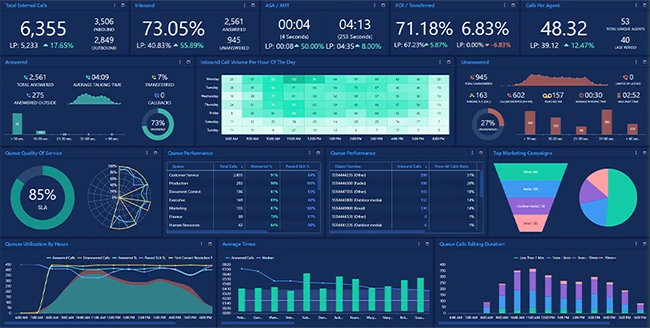Metrics-Driven CX: Measuring What Matters

In today’s customer-centric business world, metrics-driven CX is not a buzzword—it’s a proven strategy for improvement. Contact centers that track the right key performance indicators (KPIs) can streamline operations, improve customer satisfaction, and build long-term loyalty. But it’s not just about numbers; it’s about using those numbers to drive better decisions, smarter automation, and empowered teams.
This article explores essential metrics that matter most, especially for SMBs, and how AI and feedback loops can enhance measurement and action.
Why Metrics Matter in Customer Experience
Contact center metrics serve as a compass for organizations navigating the complexities of modern CX. Manu Parhar of Webex by Cisco identifies 11 core KPIs in his article “11 Most Valuable Metrics”, including:
First Contact Resolution (FCR)
Customer Satisfaction Score (CSAT)
Net Promoter Score (NPS)
Average Handle Time (AHT)
Service Level Rate (SLR)
These KPIs provide clarity on what’s working—and what’s not.
FCR, CSAT, and NPS: The Golden Trio
Michael Wiesblatt of Genesys highlights that 88% of Baby Boomers value FCR, making it a vital driver of satisfaction. CSAT captures real-time feedback on interaction quality, while NPS measures long-term loyalty—key for brand advocacy.
Reducing Volume with Call Intent Analysis
Joe O’Brien from Sabio Group emphasizes using call intent analysis to improve metrics. A fire safety provider reduced call volumes by 17% by launching an online portal, directly impacting:
Call arrival rate
Average abandonment rate
FCR
Parhar’s analytics dashboards allow teams to act on these insights quickly, improving CSAT and driving operational improvements.
Key Metrics for SMBs: Speed, Simplicity, and Satisfaction
Nicholas Clapper from Cloudli recommends focusing on four core CX pillars:
Speed (measured via First Response Time – FRT)
Convenience (tracked with Customer Effort Score – CES)
Knowledgeable Help
Friendly Service
SMBs often lack complex tools, but metrics like FRT and CES provide actionable insights. The Seattle Times leveraged automation to cut hold times and boost FRT, using Enghouse’s cloud solution as a model for success.
Clapper also highlights skills-based routing, which matches customers to the right agent—improving FCR and CSAT simultaneously.
AI’s Role in Enhancing Contact Center Metrics
AI isn’t just automation—it’s optimization.
Pablo Sanchez of Atento shows how their AI Center of Excellence (CoE) embedded AI into CRM, resulting in:
22% improvement in CSAT
50% reduction in resolution times
Lower AHT, without sacrificing quality
Patrick Martin of Coveo adds that generative AI boosted self-service resolution by 20% at Xero. This improved both CES and FCR, while enhancing personalization—an NPS driver. Martin’s unified AI strategy ensures seamless data usage, aligned with Parhar’s analytics models.
Avoiding Common Pitfalls with Metrics
Metrics must be meaningful—not just flashy.
Shane Devitt warns against overused buzzwords like “next-gen CX” in “The CX Buzzword Hall of Shame.” Poor implementations often inflate AHT and frustrate agents.
Jessica Petrie and Jim Katzman highlight another challenge: increased call volumes due to government service cuts, which strain FRT and FCR. Monitoring blocked call percentage, as Parhar suggests, ensures service levels remain high under pressure.
Chris Albrecht from Here.io advocates for enterprise browsers, which cut AHT by 80%—saving $8 million per 1,000 agents. The analytics from these tools help reduce agent burnout and turnover, a critical metric for long-term sustainability.
Leveraging Feedback for Continuous Improvement
Parhar stresses the value of post-call surveys and real-time feedback. When combined with:
Call transcripts
Online reviews
Sentiment analysis
… organizations gain a 360° view of CX. Joe O’Brien’s call intent insights guide training and system updates, improving first-contact outcomes.
Clapper recommends SMB-friendly tools that can ingest and act on feedback without heavy IT investments. Atento’s use of minimum viable products (MVPs) allowed rapid testing and optimization of strategies, delivering measurable gains in AHT, CSAT, and FCR.
The Metrics-Driven Future of CX
The path to exceptional customer experience is paved with data. From AI-powered personalization to low-friction feedback loops, leading contact centers are investing in metrics that matter.
To summarize, here’s how to drive metrics-driven CX:
Use FCR, CSAT, and NPS as primary indicators
Leverage AI and automation to enhance speed and accuracy
Implement intent analysis to reduce unnecessary volume
Choose metrics that align with your CX goals—especially for SMBs
Act on feedback consistently to evolve service quality
By embracing data, simplifying processes, and focusing on meaningful outcomes, contact centers can build loyalty and deliver standout service at scale.
✅ Ready to Take Your CX Metrics to the Next Level?
Start measuring what truly matters.
👉 Schedule a free CX metrics audit or learn how our AI-powered dashboards can help you enhance customer satisfaction and agent performance.


